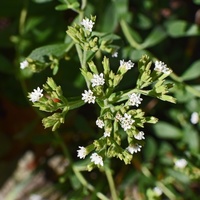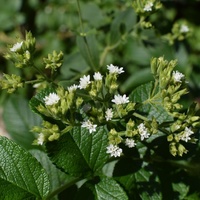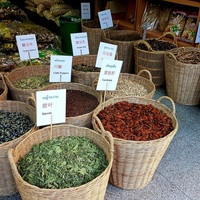Common name: Stevia
Other common names: Candy leaf, Sugar leaf, Sweetleaf, Sweet honey leaf, Sweet herb of Paraguay
Description
Stevia is a short-lived perennial herb with leaves used as a natural sweetener. Originating in South America, in moist hilly areas in eastern Paraguay, it is now cultivated worldwide, including Brazil, Taiwan, India, and the United States.
A small shrub with a bushy appearance, it reaches up to 80 cm (2.6 ft) tall and consists of semi-woody stems, on top of which grow pairs of short-stalked, green, elongated oval leaves toothed around the top half.
The flowers are small, white and five-petaled. They are encouraged into bloom by shortening day lengths from autumn to winter and are followed by tiny tufted seed designed for wind dispersal.
Due to selective breeding, there are wide variations in plant height, leaf size, leaf shape, and sweetness.
Use
The leaves have been used as a sweetener for hundreds of years in native areas to sweeten teas and medicines. And it has recently gained popularity as a low-calorie sweetener and natural alternative to artificial sweeteners such as saccharin.
The sweetness comes from two compounds in the leaf, stevioside and rebaudioside, which, when extracted and crystallised, are many times sweeter than sugar of the same weight. The ratio of the two compounds in the leaf varies by variety, determining the degree of liquorice or bitter aftertaste. Best tasting and least bitter are varieties having a high relative rebaudioside to stevioside content.
The extraction process, in simple terms, involves soaking the leaves in hot water to dissolve out the sweet compounds. The resulting solution is then filtered and evaporated to produce a white powder or fine crystal.
Stevia is used commercially as a non-caloric sweetening agent, particularly in Japan, Brazil and Paraguay. In Japan, it is used in confectionery, chewing gum, mints, non-alcoholic drinks, pickles, dried seafood, soy sauce and miso-based products. Due to its non-fermenting and non-browning properties and its high stability to heat and acid, it also has application in baked goods.
The leaves are also a rich source of chlorophyll. Chlorophyll is extracted from the leaves of selected plants for use in cosmetics, toiletries such as toothpaste, and as a natural green colouring agent, especially in foods not requiring any heat treatment, such as chilled desserts. Chlorophyll is high in Vitamin K and, for this reason, is being widely promoted as a blood and liver tonic.
The wetted leaves in a leaf bag placed over the eyes is reportedly effective in tightening the skin and smoothing out wrinkles.
Health use
Stevia is a non-caloric sweetener, making it suitable for use by people with diabetes and on weight-loss diets.
Climate
Short day lengths and lack of moisture induce flowering in Stevia, usually at the expense of leaf production. For this reason, subtropical and temperate areas with long summer days are better suited than tropical areas for cultivating Stevia, as are areas with adequate moisture during the growing period. Stevia is grown as a perennial in temperate to warm climates but as an annual in colder regions.
Grows naturally and is productive in moderately humid subtropical and tropical mid- to high-elevation climates, generally frost-free areas with annual lows of 9 to 20°C, annual highs of 19 to 32°C, annual rainfall of 800 to 2200 mm and a dry season of 6 months or less.
Stevia can also be grown with irrigation in areas with low rainfall and a long dry season and is cultivated with irrigation in the Indian states of Gujarat and Punjab, in areas with annual rainfall of less than 1000 mm and a dry season of up to 8 months.
Growing
New plants are started from seed or cuttings, but seedlings do not come true to type, so cuttings are preferred. Cuttings are best taken from known varieties with desirable characteristics, such as a reduced tendency to flower and a high rebaudioside to stevioside ratio.
Planting is done in subtropical regions in spring to early summer and in tropical regions when there is sufficient soil moisture. It is also well suited for growing in a container.
Performs best on rich, moist, free-draining loam and sand soils of a moderately acid to neutral nature, generally with a pH of 6.0 to 7.5, and on sites with full to partial sun exposure. It has poor tolerance to drought.
Problem features
It is recorded as having naturalised in Japan. Still, there does not appear to be any record of it anywhere as a serious weed or invasive species.
Where it grows
References
Books
-
Byrne, T. & Bourke, M. & Salvin, S. 2004, The new crop industries handbook, Rural Industries Research and Development Corporation (RIRDC), Canberra, Australia
-
Farooqi, A. A. & Sreeramu, B. S. 2004, Cultivation of medicinal and aromatic crops, Hyderabad University Press, Hyderabad
-
Khan, I. A. & Abourashed, E. A. 2010, Leung's encyclopedia of common natural ingredients : used in food, drugs and cosmetics, 3rd edition, Wiley Publishing, Hoboken, New Jersey
-
Randall, R. P. 2002, A global compendium of weeds, R.G. and F.J. Richardson Press, Melbourne
-
Randall, R. P. 2007, The introduced flora of Australia and its weed status, Cooperative Research Centre for Australian Weed Management, Glen Osmond, South Australia
-
Van Wyk, B. E. 2005, Food plants of the world: an illustrated guide, 1st ed., Timber Press, Portland, Oregon




